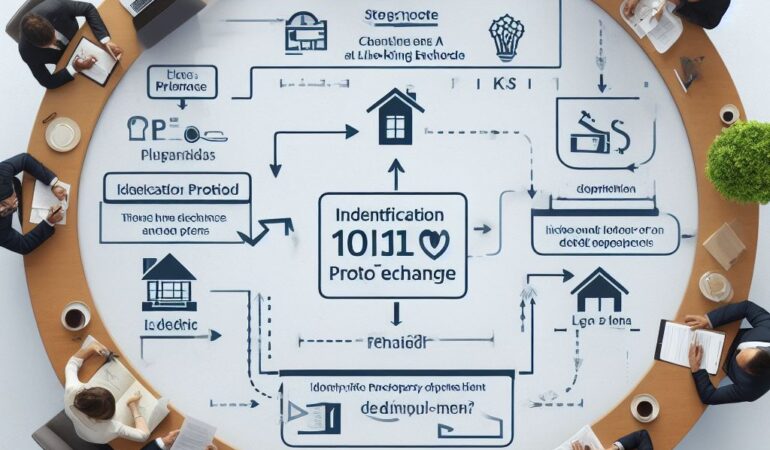Embark on a journey through the intricate landscape of 1031 exchange rules. Here, you’ll navigate eligibility requirements, explore various exchange types, unravel replacement property rules, stay on top of timelines and deadlines, and unlock the tax implications and benefits that await.
With this comprehensive guide as your compass, you’ll gain the knowledge and insights needed to successfully navigate the world of 1031 exchanges. So, buckle up and prepare to dive deep into the realm of tax-deferred exchanges.
Key Takeaways
- Eligibility and Requirements: The property must be held for investment or used in a trade or business, personal residences do not qualify. The relinquished and replacement properties must be of like-kind. There are also time limits for identifying and acquiring replacement properties.
- Types of 1031 Exchanges: There are two main types of exchanges – simultaneous exchange and delayed exchange. Simultaneous exchange involves selling the relinquished property and acquiring the replacement property on the same day. In a delayed exchange, the relinquished property is sold first, and potential replacement properties are identified within a specific timeframe.
- Replacement Property Rules: Replacement property must be identified within 45 days of selling the relinquished property. Up to three potential replacement properties can be chosen, or any number as long as their total value does not exceed 200% of the relinquished property’s value. The replacement property must be like-kind to the relinquished property, and there are restrictions on acquiring replacement property from a related party.
- Timelines and Deadlines: There are specific timelines and deadlines to be followed in a 1031 exchange. The identification period is 45 days to identify potential replacement properties in writing, with a limit of three properties or any number not exceeding 200% of the relinquished property’s value. The exchange period is 180 days from the sale of the relinquished property or the tax return due date to acquire and close on the replacement property.
Eligibility Requirements
To be eligible for a 1031 exchange, you must meet certain criteria and adhere to specific rules set forth by the IRS. First and foremost, the property that you intend to exchange must be held for investment or used in a trade or business. Personal residences don’t qualify for 1031 exchanges.
Additionally, both the relinquished property (the property you’re selling) and the replacement property (the property you’re acquiring) must be of like-kind. This means that they must be of the same nature or character, even if they differ in quality or grade.
Furthermore, there are strict time limits that must be followed in a 1031 exchange. Within 45 days of selling your relinquished property, you must identify potential replacement properties in writing. You can identify up to three properties, or any number of properties as long as their combined fair market value doesn’t exceed 200% of the value of the relinquished property. After identifying the replacement properties, you must acquire them within 180 days of selling your relinquished property.
In conclusion, to be eligible for a 1031 exchange, you must meet criteria such as holding the property for investment or business purposes and ensuring the properties involved are like-kind. Additionally, you must adhere to strict time limits for identifying and acquiring replacement properties.
Now that we’ve covered the eligibility requirements, let’s move on to discussing the different types of 1031 exchanges.
Types of 1031 Exchanges
There are three main types of 1031 exchanges that you can utilize to defer capital gains tax. Understanding the different types will help you determine which one is best for your specific situation.
Here are the three types of 1031 exchanges:
- Simultaneous Exchange:
- This is the simplest type of exchange where you sell your relinquished property and acquire the replacement property on the same day.
- The timing and coordination of both transactions are critical to ensure a successful exchange.
- Delayed Exchange:
- In a delayed exchange, you sell your relinquished property first and then have a certain timeframe, known as the identification period, to identify potential replacement properties.
- Once you’ve identified the replacement property, you must acquire it within the exchange period, typically 180 days from the sale of your relinquished property.
- Three-Property Rule:
- Under this rule, you can identify up to three potential replacement properties, regardless of their value.
- 200% Rule:
- This rule allows you to identify any number of replacement properties, as long as the total fair market value doesn’t exceed 200% of the relinquished property’s value.
Replacement Property Rules
Now let’s dive into the rules for identifying and acquiring replacement properties in a 1031 exchange.
In order to successfully complete a 1031 exchange, you must follow certain guidelines when it comes to selecting your replacement property.
Firstly, you need to identify your replacement property within 45 days from the date of the sale of your relinquished property. You can choose up to three potential replacement properties, known as the Three Property Rule, or any number of replacement properties as long as the total fair market value of the identified properties doesn’t exceed 200% of the fair market value of the relinquished property.
Secondly, you must acquire the replacement property within 180 days from the date of the sale of your relinquished property, or the due date of your tax return for that year, whichever comes first. The replacement property must have an equal or greater value and equity than the relinquished property.
Moreover, the replacement property must be like-kind to the relinquished property. This means that both properties must be held for investment or used in a trade or business. The IRS provides a broad definition of like-kind property, allowing for exchanges of various types of real estate properties.
Lastly, it’s important to note that you can’t acquire the replacement property from a related party, such as a family member or a business partner. However, if you sell your relinquished property to a related party, you must hold the replacement property for at least two years to comply with the related party rules.
Understanding and adhering to these replacement property rules is crucial to successfully completing a 1031 exchange.
Timelines and Deadlines
Once you have identified your replacement property and followed the rules for selecting it, it’s important to understand the timelines and deadlines that must be met in order to successfully complete a 1031 exchange. Timeliness is crucial in this process, as failing to meet the necessary deadlines can result in disqualification of the exchange and potential tax consequences.
Here are the key timelines and deadlines to keep in mind:
- Identification Period:
Within 45 days of selling your relinquished property, you must identify potential replacement properties. This identification must be done in writing and submitted to a qualified intermediary. You can identify up to three replacement properties of any value, or any number of properties with a total value not exceeding 200% of the relinquished property’s value.
- Exchange Period:
The exchange period begins on the date of sale of the relinquished property and ends within 180 days or the due date of your tax return, whichever comes first. During this period, you must acquire and close on the replacement property or properties identified within the 45-day identification period.
Tax Implications and Benefits
To fully understand the tax implications and benefits of a 1031 exchange, it is important for you to carefully consider the financial advantages that come with this type of transaction. A 1031 exchange allows you to defer capital gains taxes when you sell a property and reinvest the proceeds into a like-kind property. By deferring taxes, you can potentially increase your purchasing power and grow your real estate portfolio more effectively.
One of the main tax benefits of a 1031 exchange is the ability to defer capital gains taxes. Instead of paying taxes on the gains from the sale of your property, you can reinvest the proceeds into a new property and defer those taxes until you sell the replacement property. This can provide significant tax savings and allow you to reinvest your money into more valuable properties.
Additionally, a 1031 exchange can help you avoid depreciation recapture taxes. When you sell a property, you may have to pay taxes on the depreciation you claimed over the years. However, with a 1031 exchange, you can defer these taxes and keep more of your profits to reinvest in other properties.
To better understand the tax benefits of a 1031 exchange, consider the following table:
| Tax Benefit | Explanation |
|---|---|
| Capital Gains Deferral | Defer taxes on the gains from the sale of your property. |
| Depreciation Recapture Deferral | Defer taxes on the depreciation recapture when selling a property. |
| Increased Purchasing Power | By deferring taxes, you can reinvest more money into your new property. |
| Portfolio Growth | Use the tax savings to acquire more valuable properties and grow your portfolio. |
Frequently Asked Questions
What Are the Potential Risks Involved in a 1031 Exchange?
When considering a 1031 exchange, it’s important to be aware of potential risks. These can include the possibility of not finding a suitable replacement property within the 45-day identification period or not meeting the strict timeline requirements.
Can a Foreign Investor Participate in a 1031 Exchange?
Yes, you can participate in a 1031 exchange as a foreign investor. However, it is important to understand the specific rules and regulations that apply to your situation. Seek professional guidance for a smooth process.
Are There Any Restrictions on the Types of Properties That Can Be Exchanged in a 1031 Exchange?
There are restrictions on the types of properties that can be exchanged in a 1031 exchange. Not all properties qualify, and it’s important to understand the rules and guidelines before proceeding with the exchange.
Is It Possible to Complete a 1031 Exchange if the Replacement Property Is Located in a Different State?
Can you complete a 1031 exchange if the replacement property is in a different state? Yes, you can. As long as the property follows the 1031 exchange rules, you can exchange properties across state lines.
Can a 1031 Exchange Be Used to Defer Taxes on the Sale of a Primary Residence?
Yes, you can use a 1031 exchange to defer taxes on the sale of a primary residence if it meets certain criteria. The property must have been used as your primary residence for at least two out of the last five years.




